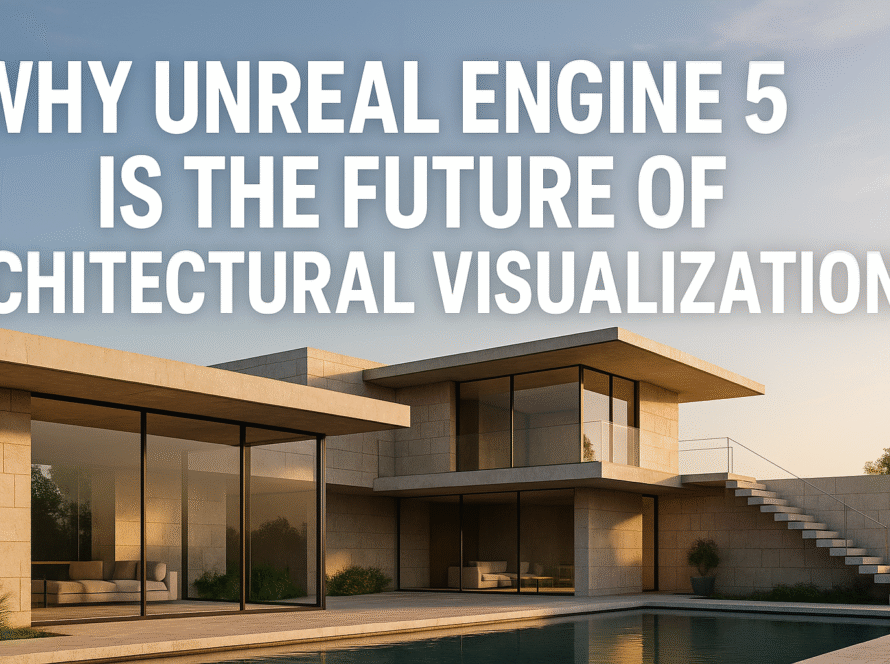For decades, architectural visualization lived in a realm of patience and post-processing. We meticulously modeled, painstakingly lit, set up complex render farms, and waited – sometimes hours, sometimes days – for a single, perfect, static image or a carefully choreographed fly-through. It was powerful, it was beautiful, but it was fundamentally limited. Enter the game engine. No longer confined to the world of headshots and high scores, engines like Unreal Engine and Unity are storming the AEC (Architecture, Engineering, and Construction) industry, fundamentally reshaping how we design, communicate, and experience unbuilt spaces. And here’s the thing: they’re not just a new tool; they’re the undeniable future of architectural visualization.
Goodbye Waiting Room, Hello Real-Time
Let’s start with the most visceral shift: real-time rendering. This is the game-changer (pun absolutely intended). Imagine tweaking a material – wood grain, stone texture, fabric sheen – and seeing the change reflected instantly under accurate lighting. Move the sun? The shadows dynamically shift across your model. Swap out furniture? It’s there, integrated, in seconds. This obliterates the agonizing render-wait-tweak-repeat cycle.
- Iteration at Warp Speed: Design is iterative. Game engines allow architects and designers to explore dozens of variations – finishes, layouts, lighting schemes, even structural elements – in the time it used to take to produce one or two renderings. This fosters creativity and leads to better-informed design decisions.
- Client Collaboration Revolutionized: Presenting to a client? Instead of static slides, you drop them into a fully navigable, photorealistic model of their future home, office, or cityscape. They can walk through spaces at their own pace, look out windows, open doors (virtually), and experience the scale and flow firsthand. This level of immersion fosters deeper understanding, builds excitement, and drastically reduces the “I didn’t picture it like that” moments that plague traditional presentations.
The Immersion Imperative: VR, AR, and the Power of “Being There”
Game engines are the native platform for Virtual Reality (VR) and Augmented Reality (AR). This is where architectural visualization transcends viewing and becomes experiencing.
- VR: Walking in the Unbuilt: Putting on a VR headset powered by Unreal Engine or Unity isn’t just looking at a model; it’s standing inside it. Clients and stakeholders can truly grasp spatial relationships, ceiling heights, lighting ambiance, and even potential issues (like a beam feeling too low) in a way no 2D drawing or fly-through video can replicate. It’s empathy for space made digital.
- AR: Overlaying the Future: Imagine pointing a tablet or AR glasses at a construction site and seeing the finished building superimposed perfectly. Or visualizing how a new piece of furniture would look and fit in your existing living room. Game engines make this contextual, real-world visualization seamless and compelling, bridging the gap between plans and reality.
Democratization and Accessibility (It’s Not Just for Coders Anymore)
The perception that game engines are only for hardcore programmers is outdated. The tools have evolved dramatically:
- Artist-Friendly Interfaces: Unreal Engine’s Blueprints visual scripting and Unity’s Bolt allow complex interactions and logic to be built without writing traditional code. Drag, drop, connect.
- Specialized Plugins & Workflows: Tools like Datasmith (Unreal) and Unity Reflect streamline importing models directly from BIM (Building Information Modeling) software like Revit, Archicad, and SketchUp, preserving crucial data and geometry.
- Asset Libraries: Massive, high-quality libraries (Quixel Megascans integrated into Unreal, Unity Asset Store) offer thousands of photorealistic materials, vegetation, furniture, and props, drastically reducing modeling time.
- Purpose-Built Solutions: Applications like Twinmotion (built on Unreal) and Unity’s focus on AEC provide tailored interfaces specifically for architects and designers, lowering the initial learning curve.
Beyond Pretty Pictures: Data, Simulation, and the Living Model
Game engines aren’t just about looks; they’re powerful simulation environments. This opens incredible doors for architectural visualization:
- Performance Visualization: Simulate sunlight and shadows throughout the day and year to analyze solar gain, glare, and natural lighting effectiveness dynamically. Visualize wind flow, acoustics, or pedestrian movement within a space or urban environment.
- BIM Data Integration: Link visualization directly to the underlying BIM data. Click on a virtual door and see its fire rating, material specs, or maintenance schedule. This transforms the visualization from a marketing tool into an interactive project information hub.
- Operational Planning & Training: Visualize complex logistics for construction sequencing, safety planning, or facility management. Train staff in virtual replicas of operational environments (hospitals, factories, airports) before they are built.
The Cost Equation: Efficiency is King
While mastering high-end visualization in a game engine has a learning curve, the long-term efficiency gains are undeniable:
- Reduced Render Costs: Eliminate expensive render farm fees. Real-time means the “render” happens instantly on your workstation or even a powerful laptop.
- Faster Project Turnaround: Iterate faster, present changes instantly, get client sign-off quicker. Time saved is money saved.
- Multi-Purpose Output: From a single real-time model, you can generate high-res stills, cinematic videos, fully interactive walkthroughs (PC/Mac/web/mobile), VR experiences, and AR applications. One source, infinite deliverables.
The Future is Interactive, Connected, and Intelligent
Looking ahead, game engines are poised to push architectural visualization even further:
- The Metaverse & Digital Twins: As concepts like the metaverse evolve, game engines are the foundational platforms. Architectural visualizations will become persistent, interactive spaces within larger digital ecosystems – true digital twins used for ongoing management, simulation, and user experience.
- AI Integration: Imagine AI tools within the engine that can suggest design alternatives based on constraints, automatically optimize lighting, generate contextually appropriate landscaping, or even populate spaces with virtual occupants exhibiting realistic behaviors.
- Cloud-Based Collaboration: Real-time collaborative design reviews within the visualization model, accessible from anywhere in the world via the cloud, will become standard.
- Hyper-Personalization: Clients could customize finishes, furniture, and layouts in real-time within the visualization, instantly seeing the impact on aesthetics, cost (linked to BIM data), and even performance (e.g., energy use).
Overcoming the Challenges: It’s a Journey, Not a Destination
Adopting game engines isn’t without challenges. There is a learning curve, especially when moving beyond basic visualization to complex interactivity and data integration. Optimizing massive architectural models for real-time performance requires new skills. Workflows need adapting. Hardware demands (especially for high-fidelity VR) can be significant.
But these are hurdles, not dead ends. The industry is rapidly developing solutions: better optimization tools, more seamless BIM integrations, cloud rendering for heavy lifting, and increasingly accessible learning resources. The trajectory is clear, and the benefits overwhelmingly outweigh the growing pains.
The Verdict: Not Just an Option, The Platform
Game engines are no longer a niche experiment in architectural visualization. They represent a paradigm shift. They deliver unprecedented speed, interactivity, immersion, and flexibility. They break down communication barriers between designers, clients, and builders. They turn static presentations into dynamic experiences and passive viewers into active participants.
The future of architectural visualization isn’t about waiting for a render to finish. It’s about stepping inside the design now, exploring it freely, interacting with it meaningfully, and using it as a powerful tool for decision-making, collaboration, and storytelling. Game engines provide the platform for that future. They are transforming how we conceive, communicate, and ultimately construct our world. The future isn’t just visualized; it’s experienced – in real-time. And that future is powered by game engines.

